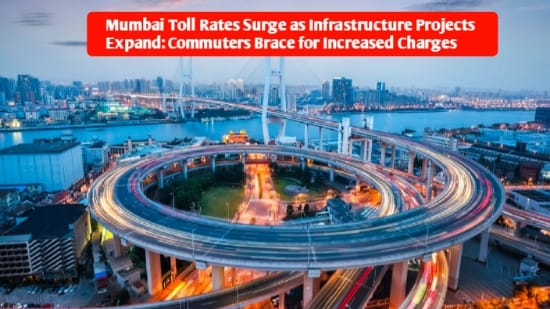Mumbai Toll Rates Surge as Infrastructure Projects Expand: Commuters Brace for Increased Charges. For instance, private car owners who regularly use the Eastern Express Highway will now have to pay ₹50
Mumbai Toll Rates Surge as Infrastructure Projects Expand
Mumbai, India’s financial capital, is witnessing a significant rise in toll rates as the city undergoes rapid infrastructure development. The Maharashtra government’s recent announcement of toll hikes across several key highways and expressways has stirred reactions from commuters, transport companies, and local authorities alike. This toll hike, aimed at funding the ongoing and upcoming infrastructure projects, is expected to have far-reaching impacts on daily commuters, freight transport, and the city’s overall traffic management.
New Toll Rates and Impact on Commuters
As of the latest revisions, toll rates at major entry and exit points to the city have seen an increase ranging from 10% to 18%, depending on the type of vehicle and the route. Prominent toll booths such as those at Mulund, Vashi, Dahisar, and Airoli are now charging higher fees from private vehicles, commercial trucks, and public transport buses.
For instance, private car owners who regularly use the Eastern Express Highway will now have to pay ₹50, up from ₹45, at the Mulund toll plaza. Similarly, commercial vehicles, including trucks and buses, will experience a higher hike, with some categories seeing their charges increased by ₹30 to ₹50 per trip. This will not only affect the daily commuters but also increase the operational costs for businesses reliant on freight transportation.
Infrastructure Projects Driving the Toll Hikes
The toll hikes are justified by the government as essential for funding the ambitious infrastructure projects aimed at reducing congestion in the city. The toll collected will primarily go toward projects such as the ongoing Mumbai Trans Harbour Link (MTHL), the expansion of the Mumbai-Pune Expressway, and the construction of several flyovers and metro corridors.
- Mumbai Trans Harbour Link (MTHL): This 21.8 km-long sea bridge, connecting Sewri in Mumbai to Nhava Sheva, is touted to be the longest sea link in India. Once completed, it is expected to drastically reduce travel time between Mumbai and Navi Mumbai. The government plans to use part of the toll collection to fund its construction and maintenance.
- Expansion of the Mumbai-Pune Expressway: With the increase in traffic between Mumbai and Pune, the government has embarked on expanding this expressway to improve travel time and road safety. The toll collected from the city’s highways will support this expansion.
- Mumbai Metro Projects: A portion of the toll fees will also contribute to the city’s metro network expansion, particularly the under-construction lines 2A, 3, and 7. These lines are crucial in addressing the city’s growing demand for an efficient public transport system.
Public Reaction and Criticism
The toll hikes have elicited mixed reactions from the public. While many acknowledge the need for improved infrastructure in a rapidly growing city like Mumbai, commuters are expressing concerns about the financial burden these hikes will impose, especially on daily wage earners and middle-class families who rely on personal vehicles for their commute.
Social media platforms have been flooded with complaints about the steep rise in toll rates. Several Mumbai-based citizens’ forums have also called for protests, urging the government to reconsider the hikes, arguing that commuters are already paying high taxes for road usage and fuel. Moreover, public transport users fear that bus fares might rise to offset the increased toll expenses for bus operators.
Commercial vehicle operators, especially those involved in goods transportation, are among the most affected by the hikes. Several logistics companies have pointed out that the increased toll rates will lead to higher costs for goods, which will inevitably be passed on to consumers. The rising toll fees, coupled with fuel price fluctuations, could lead to a rise in the cost of essential goods and services.
Government’s Response
In response to the criticism, the Maharashtra State Road Development Corporation (MSRDC) has defended the toll hikes, emphasizing that the increased toll is crucial to completing infrastructure projects on time. According to MSRDC officials, these projects are vital to improving connectivity, reducing congestion, and boosting Mumbai’s economy in the long term.
An MSRDC spokesperson stated, “We understand the concerns of the public, but the toll hikes are essential for the completion of projects that will ultimately benefit the city’s commuters. Without these funds, projects like the Trans Harbour Link and Metro expansions will face delays, which will only increase congestion and traffic woes for the city’s residents.”
The government has also announced that the toll rates will be reviewed periodically, and adjustments will be made as the projects progress. However, there has been no commitment to roll back or reduce the current hikes.
Future Outlook
As the toll rates increase, Mumbaikars will need to brace for the financial strain in the short term. However, experts believe that once the city’s major infrastructure projects are completed, the improved connectivity and reduced travel times will make commuting easier, potentially justifying the current toll rates.
For now, the toll hike remains a hotly debated topic in Mumbai, as residents weigh the immediate impact on their wallets against the long-term benefits of a better-connected and more efficient city.
In the coming months, all eyes will be on the progress of Mumbai’s infrastructure projects and whether the benefits they promise will be worth the higher tolls paid by the city’s millions of commuters.
How did you like the information given in our article today, please tell us in the comment section and for more such posts, follow our page The News House, thank you
Reed more…. POONAM PANDEY: A JOURNEY FROM CONTROVERSIAL STARDOM TO DIGITAL FAME


